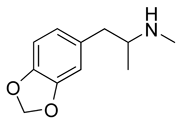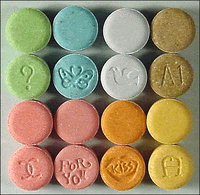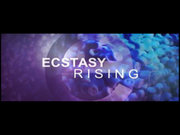IT has been called "penicillin for the soul. Take it, and in short order your mind is blown, to the point of feeling good about everyone and everything. But the hype as usual is deceptive, for the drug that is spreading throughout Black neighorhoods can lead to seizures, strokes and even death.
Ecstasy--the street name given to Methylenedioxymethamphetamine (MDMA)--can now be found in every state and virtually every town in America. It is evident in high schools, in clubs, at malls, anywhere teenagers gather. The drug, similar to LSD and Angel Dust in the `60s, first found a following in White, middle-class suburbs. But today it can be found in Black communities, inner cities, and rural Southern towns.
One $25 pill produces a high that lasts approximately four to six hours. Take more than one, either by "stacking," a term used to describe consuming many tablets at once, or "piggy-backing" a series of pills over a short period of time, and you may be able, some say, to endure two- to three-day parties without sleeping or eating. At these dance parties, wired teens convulse, gyrate and flail their bodies to music while sucking on pacifiers to keep from biting their tongues. (A side effect of Ecstasy is involuntary teeth-clenching.)
Marketed as a "hug drug" or "love drug," Ecstasy is anything but a benign drug. In fact, doctors, psychologists and researchers say this newest version of social lubricant is just as dangerous as well-known "hard" drugs, and they denounce it as "the worst new drug to hit the streets since heroin."
"Youth today are being misled by those who seek to profit off addiction and misery," says Asa Hutchinson, director of the Drug Enforcement Administration (DEA). "Our kids are being told that club drugs like Ecstasy are safe. But we know better."
Ecstasy can also cause severe dehydration, nausea, cold sweats, chills, hallucinations, tremors, double vision, muscle cramps and increased body temperature. In fact, Ecstasy can raise a person's temperature as high as 105 to 117 degrees. When users want to "come down" from the effects of Ecstasy, they often have to resort to using other drugs, officials say.
Long-term after-effects of Ecstasy include anxiety, paranoia and depression. This is most likely attributed to the decreased levels of serotonin--a chemical that is used in learning, sleep, and integration of emotion--found in the brain for up to three weeks after Ecstasy use.
With all of the dangers, the widespread growth of the mind-altering drug has been nothing short of alarming. Even though numerous surveys indicate that overall drug use is down and that the number of teens willing to try or use illegal drugs continues to decline, the advances, unfortunately, are being partially offset by a rapid growth in the popularity of club drugs like Ecstasy.
Although fairly new in the American underground drug culture, Ecstasy has been known in the pharmaceutical community since its inception in 1912 by a German company that developed the drug as an appetite suppressant. In the 1970s, it re-emerged as an aid in psychotherapy, but was soon found to have little benefits in those circles. By the 1980s, Ecstasy had begun to surface in the illicit drug trade. In 1987, it was completely barred from use.
Despite its illegal status, the recreational use of Ecstasy has increased some 500 percent over a five-year period. Researchers and law enforcement officials say Ecstasy is used most often by young adults and teens at clubs, rock concerts, and raves (large, all-night dance parties).
The drug also has begun to appear in schools. In 2000, 8.2 percent of 12th-graders, 5.4 percent of 10th-graders and 3.1 percent of 8th-graders reported they had used Ecstasy in the past year. Today, 11 percent of high school seniors report they have tried the drug. In 2000, the DEA seized over 3 million tablets of Ecstasy, compared to slightly over 1 million tablets in 1999.
Nationwide, hospital emergency room mentions of the drug rose dramatically from 70 in 1993 to 2,850 in 1999. Seizures as a result of the drug have also increased drastically. Over a six-year period, the drug-related seizures have risen from a total of 196 in 1993 to 143,600 in 1998. In 1999, that figure more than doubled.
One explanation for the increase in overdoses is the prevalence of counterfeit Ecstasy pills. One study found that look-alike pills, including caffeine, speed, PCP or simple over-the-counter drugs, are passed off as Ecstasy 40 percent of the time. More troublesome perhaps is the fact that sometimes even more dangerous drugs are sold as Ecstasy.
Dr. Phillippe B. Cunningham, a professor in the Department of Psychiatry and Behavioral Sciences at the Family Services Research Center of the Medical University of South Carolina, says parents are the first line of defense in guiding teens away from drugs like Ecstasy. "I always tell parents to err on the side of being too concerned rather than not concerned enough," he says. "Drugs in the Black community are a big problem, but parents, by being active in their child's life, can do a great deal to ensure their child doesn't go down that road."
Cunningham concedes that it is difficult to keep a close watch on children when both parents are working full-time. He suggests teaming up with other neighborhood parents and teachers in an effort to keep adult involvement at a high level. "When the consequences are weighed, it's definitely worth the extra effort," he says.
Last year, harsher penalties for Ecstasy offenses went into effect, treating it more seriously than cocaine and almost as seriously as heroin. Under the new penalties, less than half a pound of Ecstasy will trigger a five-year sentence; in comparison, it takes over a pound of cocaine to trigger a five-year sentence.
As the guidelines are presently configured, a first-time Ecstasy trafficker potentially faces 5 to 6 years incarceration. Federal prosecutors have also used the "Crackhouse Law" to prosecute nightclub promoters, arguing that clubs that host what are called "rave" Ecstasy parties, in essence, function as crackhouses.
"These drugs are deadly ...," DEA chief Hutchinson concludes. "We face a very real challenge."
THE DEADLY FACTS ABOUT ECSTASY
* Ecstasy is distributed in tablet form. Individual tablets are often imprinted with graphic designs or commercial logos, and typically contain 100 mg of MDMA.
* Ecstasy is usually ingested in tablet form, but can also be crushed and snorted, injected, or used in suppository form.
* In 2000, more than 6.4 million people age 12 and older reported that they have used Ecstasy at least once in their lives.
* Ecstasy is popular among middle-class adolescents and young adults.
* Ecstasy is sold primarily at legitimate nightclubs and bars, at underground nightclubs sometimes called "acid houses," or at all-night parties known as "raves."
* The vast majority of Ecstasy consumed domestically is produced in Europe.
* A limited number of Ecstasy laboratories operate in the United States.
* Law enforcement seized 17 clandestine Ecstasy laboratories in the United States in 2001, compared to 7 seized in 2000.
* Ecstasy costs as little as 25 to 50 cents per tablet to manufacture in Europe, but the street value of that same Ecstasy tablet in the United States can be as high as $40, with a tablet typically selling for between $20 and $30.
* In addition to chemical stimulation, the drug reportedly suppresses the need to eat, drink or sleep.
* When taken at "raves," where all-night dancing usually occurs among teens and young adults, the drug often leads to severe dehydration and can lead to heat stroke in the user because it has the effect of "short-circuiting" the body's temperature signals to the brain.
* An Ecstasy overdose is characterized by a rapid heartbeat, high blood pressure, faintness, muscle cramping, panic attacks, and, in more severe cases, seizures or loss of consciousness. One of the side effects of the drug is jaw muscle tension and teeth-grinding. As a consequence, Ecstasy users will often suck on pacifiers to help relieve the tension.
* Ecstasy may cause hypothermia, muscle breakdown, stroke, kidney and cardiovascular system failure, possible permanent damage to sections of brain that are critical to thought and memory, and death.
COPYRIGHT 2002 Johnson Publishing Co.
COPYRIGHT 2003 Gale Group




